mobile Ansicht, to the English Version tap the flag
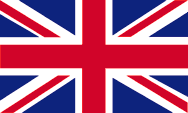

- Republik Korea (Südkorea)
- präsidiale Republik mit Mehrparteiensystem
- Eigenbezeichnung: Dachan Minkuk
• Flaggen
• historische Flagge
• Bedeutung/Ursprung der Flagge
• Wappen
• Bedeutung/Ursprung des Wappens
• Flugzeugkokarde
• Landkarte
• Zahlen und Fakten
• Geschichte
• Ursprung des Landesnamens
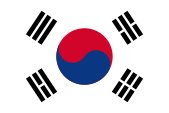
National-, Handels- und Marineflagge,
Seitenverhältnis = 2:3,
Quelle, nach: Wikipedia (D)





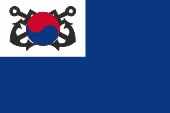
Gösch der Marine,
Seitenverhältnis = 2:3,
Quelle, nach: Flags of the World




Präsidentenflagge,
Seitenverhältnis = 2:3,
Quelle, nach: Flags of the World



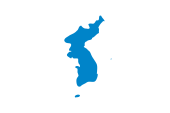
Flagge der Vereinigung,
Seitenverhältnis = 2:3,
Quelle, nach: By File:Unification flag of Korea (pre 2006).svg: Variousderivative work: Valentim (File:Unification flag of Korea (pre 2006).svg) [CC-BY-SA-3.0 or GFDL], via Wikimedia Commons




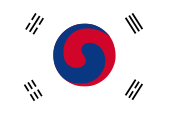
1882–1910,
Nationalflagge,
Seitenverhältnis = 2:3,
Quelle, nach: Wikipedia (DE)




Die Flagge von Südkorea basiert auf der Flagge des ehemaligen Königreichs (bis 1910) und zeigt auf einem weißen Flaggentuch ein rot-blaues Yin-Yang-Symbol, welches auf Koreanisch T'aeguk – "Große Polarität" – genannt wird, und in jeder Ecke jeweils drei, teils ganze, teils durchbrochene schwarze Balken, sogenannte Trigramme, die auf Koreanisch Kwae genannt werden. In dieser Form wurde diese Flagge erstmals im Jahre 1882 verwendet und ein Jahr später offiziell als Landessymbol anerkannt. Am 15.08.1948 wurde die Flagge für die Republik Korea (Südkorea) erneut angenommen. Am 25.01.1950 wurde sie ein wenig verändert, indem die Größe der Trigramme und auch die Größe des T'aeguk geändert wurden. Die Bezeichnung T'aeguk ist im Laufe der Zeit auf die gesamte Flagge übergegangen. Die Farbe Weiß steht für die Reinheit der Gedanken, ist aber auch die traditionelle Farbe der koreanischen Nation. Das T'aeguk ist als Yin-Yang-Zeichen in der gesamten Weltanschauungssymbolik des Ostens bekannt. Es soll die Verschmelzung der Gegensätze symbolisieren. Trigramme sind kultische Schriftzeichen aus dem Buch "I Ging" mit weltanschaulichen und kosmologischen Bezügen (Sonne, Mond, Erde, Himmel oder Frühling, Sommer, Herbst, Winter oder Süden, Westen, Norden, Osten). Die Farben Blau und Rot sind angeblich hexadezimal definiert, als Blau = #CD2E3A und Rot = #0047A0. Daraus lassen sich die Pantone-Farben Blau = pt 294 und Rot = pt 711 ableiten. Die Flagge des Präsidenten ist blau und zeigt eine goldene Hibiskusblüte, sowie links und rechts davon zwei sogenannte "Wundervögel". Die Marineflagge Südkoreas ist blau mit einer weißen Oberecke, mit zwei gekreuzten schwarzen Ankern und darauf das T'aeguk. Die "Flagge der Vereinigung" wurde anderem zur Winterolympiade 2018 gebraucht, als die Teams beider Korea unter dieser gemeinsamen Flagge auftraten.
Quelle:
Die Welt der Flaggen,
Flaggen Wappen Hymnen,
Flags of the World,
Wappen und Flaggen aller Nationen

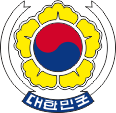
Wappen von Südkorea,
Quelle: Corel Draw 4

Das Staatswappen zeigt ein rot-blaues T'aeguk (Yin-Yang-Symbol), umgeben von den gelben Blättern der Sharon-Blüte. Sie steht für Kraft und Beständigkeit. Nach einer anderen Interpretation handele es sich jedoch um eine Hibiskusblüte, die Gastfreundschaft ausdrücken soll. In dem blauen Feld des Bandes der Name des Staates in Hangul-Schrift.
Quelle:
Flaggen Wappen Hymnen,
Flaggen und Wappen der Welt

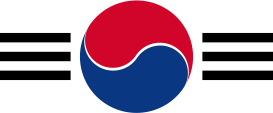
seit 2005,
Flugzeugkokarde,
Quelle, nach: Wikipedia (EN)
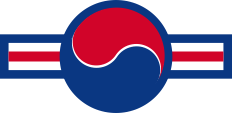
1949–2005,
Flugzeugkokarde,
Quelle, nach: Wikipedia (EN)

Lage:
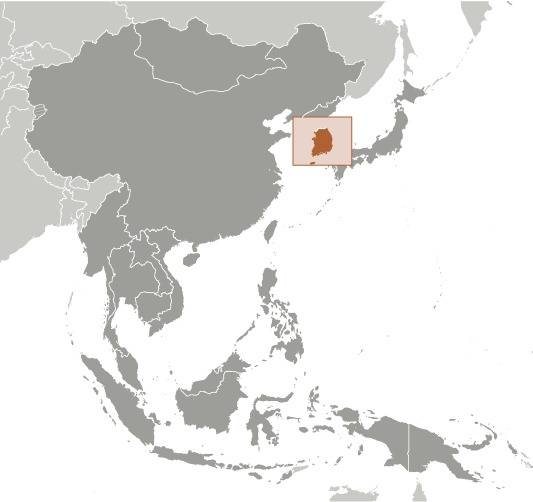
Quelle: CIA World Factbook
Landkarte des Landes:
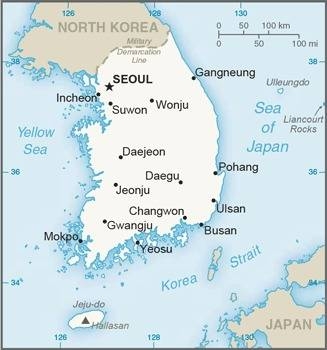
Quelle: CIA World Factbook

Fläche: 100.210 km²
Einwohner: 51.800.000 (2020), davon 99,5 % Koreaner, 0,5% Chinesen
Religionen: 28% Christen, 16% Buddhisten, 7% Koreanischer Schamanismus, 56% Nicht-Religiöse
Bevölkerungsdichte: 517 Ew./km²
Hauptstadt: Seoul (japanisch: Keijo), 9.766.886 Ew. (2019)
Amtssprache: Koreanisch
sonstige Sprachen: Englisch, Chinesisch
Währung: 1 Won (KRW, W) = 100 Chon
Zeitzone: MEZ + 8 h
Quelle:
Wikipedia (D)

ca. 1100 v.Chr. · Gründung des koreanischen Staates Choson durch Kitscha, dem ersten König des Landes und Begründer der Kitscha-Dynastie
108 v.Chr. · Unterwerfung von Choson durch China
194 v.Chr. · Herausbildung von drei koreanischen Staaten im Süden unter der Herrschaft der chinesischen Han, im Norden entsteht ein chinesischer Vasallenstaat
1. Jhd. v.Chr. · Herausbildung von drei koreanischen unabhängigen Königreichen (Goguryeo, Baekje und Silla)
668 n.Chr. · das Königreich Silla vereinigt alle drei Königreiche, Silla zerfällt jedoch nach 250 Jahren wieder in die Reiche Silla, Baekje und Madjin, Kriege zwischen den Reichen, Madjin setzt sich durch, Einigung der Reiche unter Madjin, Japan besetzt jedoch vorübergehend einen Küstenstreifen im Süden (Land Karak)
935 · General Wang Gon (Wang Kon) begründet in Madjin die Koryo-Dynastie, das vereinigte Reich wird Koryo genannt
1229 · Mongoleninvasion, Herrschaft der Mongolen bis 1280
1392 · Inthronisation der Yi-Dynastie, die von General Yi Sungye (T'aejo) begründet worden war, Umbenennung des Landes in Choson
1592–1598 · Japan versucht Choson (Korea) zu erobern
1637 · Choson (Korea) muss die Oberhoheit der chinesischen Mandschu-Kaiser anerkennen, das Land beginnt sich zu isolieren
1866 · französischer Versuch der Eroberung des Landes
1871 · US-amerikanischer Versuch der Eroberung des Landes
1876 · Japan erzwingt die Aufhebung der Isolation, Öffnung der Häfen für fremde Mächte
1894–1895 · chinesisch-japanischer Krieg um den Einfluss in Korea, China unterliegt und muss die japanische Oberherrschaft in Korea anerkennen
1904–1905 · russisch-japanischer Krieg um den Einfluss in Korea, Russland unterliegt
1910 · Japan annektiert Korea als Generalgouvernement Chôsen (Choson), Ende der Yi-Dynastie
1945 · Ende des Zweiten Weltkriegs, Japan kapituliert, Korea wird längs des 38. Breitengrads geteilt, der Norden wird von der Sowjetunion besetzt, der Süden durch die USA
06.09.1945 · in der Sowjetischen Besatzungszone wird die "Volksrepublik Korea" gegründet, deren Kompetenzen für ganz Korea geplant waren, im Süden werden alle ihre Aktivitäten am 12.12.1945 verboten
08.02.1946 · das Projekt "Volksrepublik Korea" wird beendet
10.05.1948 · Wahlen in ganz Korea für eine handlungsfähige Regierung, Nordkorea boykottiert die Wahlen
Juli 1948 · neue Verfassung für Korea
15.08.1948 · in Folge der Wahl wird (nur in Südkorea) die Republik Korea proklamiert
09.11.1948 · in Nordkorea wird die Volksdemokratische Republik Korea proklamiert
25.06.1950 · nordkoreanische Truppen marschieren in Südkorea ein, es entwickelt sich ein größerer Konflikt, in den außer Südkorea auch China die USA und jeweilige Verbündete mit hineingezogen werden
27.07.1953 · Waffenstillstand von Panmundjom, das Land bleibt entlang der Waffenstillstandslinie zwischen Nord- und Südkorea geteilt
1961 · Militärputsch
1963 · Präsidentenwahlen
1965 · Wiederaufnahme diplomatischer Beziehungen zu Japan
1966 · Südkorea beginnt sich am Vietnamkrieg zu beteiligen
1972 · Kriegsrecht, neue Verfassung, Präsidialdiktatur
1979 · Militärputsch
1985 · kleinere Abkommen zwischen beiden Koreas
1988 · neue Verfassung, Mehr-Parteien-System
1990 · Kontakte beider koreanischer Regierungen
1991 · Südkorea tritt der UNO bei
1992 · Wiederaufnahme diplomatischer Beziehungen zu China
1992 · "Vertrag über Versöhnung, Nichtangriff, Austausch und Zusammenarbeit" zwischen beiden Koreas, jedoch Zunahme der Spannungen zwischen beiden Staaten
1997 · Friedensverhandlungen zwischen Nord- und Südkorea unter Beteiligung der USA und Chinas
2000 · verschiedene humanitäre Verbesserungen der Beziehungen zwischen beiden Koreas
ab 2008 · Verschlechterung der Beziehungen zwischen beiden Koreas
ab 2013 · Verbesserung der Beziehungen zwischen beiden Koreas
Quelle:
Atlas zur Geschichte,
Wikipedia (D),
World Statesmen

Der Name "Korea" wurde im Mittelalter durch Handelsreisende nach Europa gebracht. Entweder bezog sich diese Bezeichnung auf den koreanischen Staat "Koguryo" der zwischen dem 1. Jhd. v.Chr. und dem 7. Jhd. n.Chr. auf der koreanischen Halbinsel bestand, oder die Bezeichnung geht zurück auf die Dynastie "Koryo", welche die koreanischen Staaten im Jahre 936 vereingte, und dem Land "Koryo" seinen Namen gab. Im Jahre 1392 kam die Dynastie "Yi" an die Macht (bis 1910), welche das Land im gleichen Jahr in "Choson" (Land der Morgenfrische) umbenannte. Diese Bezeichnung wird heute noch von Nordkorea verwendet. Südkorea nennt sich "Dachan Minkuk". International wird jedoch ausschließlich Korea (Nordkorea oder Südkorea) verwendet.
Quelle: Handbuch der geographischen Namen, Volker Preuß


![]()





















